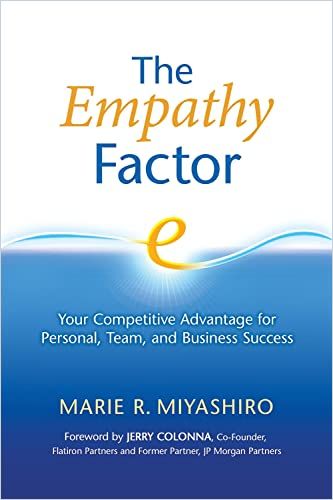Fortune 500 Consultant Marie Miyashiro explains the virtues of empathy and how to build an empathetic – and thus more effective – workplace.

Applying Empathy
Introducing empathy
Fortune 500 Consultant Marie Miyashiro – founder and president of Elucity Network Inc. – tells you how to introduce empathy into your business. She defines empathy as “the intention to create an emotional connection through human needs,” and presents it as a hallmark of unified organizations.
Connect with your own internal state, connect with others…and connect with [your] whole team. Marie R. Miyashiro
Empathy enables some significant changes. First, it empowers a company by developing connections among employees. When leaders extend empathy, they help their employees feel understood, find meaning in their work, and manifest positive change. However, if you manipulate – the opposite of empathetic behavior – your employees, you’re exploiting their fears and ignoring their needs, even if you are offering rewards as behavioral incentives. Unless you fulfill their needs, employees will lose interest in bribes and their work will stagnate.
Miyashiro enumerates other benefits of exercising empathy, including lower costs, higher profits, improved productivity, increased revenue, and fewer accidents and absences. She urges companies to try to meet their employees’ needs for physical and mental well-being and safety, personal empowerment, honesty, creativity, and a culture in which they can rely on their colleagues.
Pay attention to your staff members’ achievements and celebrate their milestones. Clarify the emotions that arise at work, individually or organizationally, and connect those emotions to your employees’ needs.
Empathy is purposeful.
In successful work environments, leaders and workers respect one another. Employees trust their leaders to help solve problems. Good relationships fuel the drive to complete goals. In such settings, you shouldn’t need to manage your best employees. Give them freedom and opportunity, and they will perform and grow.
To offer empathy, observe someone carefully and try to determine what he or she might be feeling. Consider what needs those emotions might indicate. Apply empathetic listening using your ears, eyes, and emotions to come to understand each individual on a deeper level. As you think about people’s situations and endeavor to reach nonjudgmental conclusions, Miyashiro advises trying hard not to filter your observations through your own biases, feelings, or needs.
Empathy’s power comes to the fore when people make changes to meet mutual needs. People often mistake empathy for weakness, but true empathy is kind and purposeful. It establishes mutual connections that nourish change, productivity and positive outcomes.
You also need to receive empathy, and once you figure out your own needs, you’ll be able to address them and express them to others.Your thoughts are not your emotions; separate them. Emotions can play a significant role in the choices you make if your thinking doesn’t co-opt them. When you overthink, you cut yourself off from the wisdom of your emotions and undermine your ability to determine what you really need and want.
Good leaders focus on values, not policies.
When a work environment thwarts the innate human urge to experience empathy, people disconnect. To prevent that and to keep your employees connected, exercise the traits that mark the best leaders. Miyashiro cites some examples listed by The Center for Creative Learning, which says that the best leaders have integrity, listen empathetically, and articulate clearly. They demonstrate sensitivity to others’ needs, and they make values and principles – not policies and procedures – paramount inside their companies.
Increased success, productivity, profitability and richness of empathy, compassion and meaning are possible if we each endeavor to develop empathic connection as a professional skill.
People’s needs affect the results of their work. To work hard, people need a sense of purpose. When that is gone, they can lose their connection to their co-workers and their company as well. Empathy instills purpose and “humanizes the workplace” for employees, customers, and other stakeholders.
Empathy enables you to make “observations instead of judgments” and to discern other people’s needs by practicing intentional clarity as you consider their “observations, feelings, needs, and requests.” Intentional clarity is particularly useful in performance reviews where it enables managers to give employees observational feedback, not just evaluations.
Empathetic Meetings
When you lead a meeting, establish the principle that all participants have a say; everyone who wishes to speak is entitled to be heard. Encourage all participants to commit to full engagement and to try to understand what they add to the mix and what they might receive.
Keep track of the requests people make in the meeting and the agreements they reach. Be transparent, note which approaches work, set purposeful goals, and make sure that everyone is on the same page. Don’t neglect the information and feedback you can gather after a meeting. Find out how people feel, Miyashiro urges. Ask what they learned.
When people in authority assert their power as a matter of principle rather than based on need, and when people with less authority operate out of fear, there won’t be enough trust for collaboration. (Miki Kashtan, co-founder, Bay Area Nonviolent Communication)
When two people communicate, usually one speaks and the other listens. When you speak, offer your observations, explain your feelings, communicate about met and unmet needs, and state your requests. Be as transparent as possible, even if that makes you uncomfortable.
When you listen, be as silent as you can. Ask appropriate, clarifying questions. Offer observations about the speaker’s needs, and ask if he or she is requesting something from you. Observe without judging.
Compassion
Anger, guilt, fear, and shame are common in the workplace. When they arise, it’s important to think about where they originated. Often, your anger isn’t being triggered by someone else’s actions, even if you think that person is behaving badly. Your anger stems from unmet needs, such as hurt or fear. Anger destroys empathy.
Empathy is valued currency. It allows us to create bonds of trust; it gives us insights into what others may be feeling or thinking; it helps us understand how or why others are reacting to situations; it sharpens our ‘people acumen’ and informs our decisions. (Bruna Martinuzzi, founder, Clarion Enterprises Ltd.)
Anger, shame, guilt, and fear are toxic and lead to lower productivity. You may not communicate well with someone for a variety of reasons, but that doesn’t mean the other person is difficult or did something wrong. Perhaps the two of you have similar unmet needs or your values clash. As you work to resolve conflicts, remember that feelings can change.
If you perceive someone as difficult, avoid communicating with him or her when you’re upset. When you must interact, empathize with yourself. Talk to the person who has upset you. Clearly express what bothers you, share your needs, and ask if the two of you can move toward a solution.
Clarity
Marie Miyashiro offers sound methods for increasing your use of empathy, extending it to your employees, your business, your patrons, and your stakeholders, and inspiring it in others. Unfortunately, she masks many of her best ideas in jargon and apparent attempts to create new catchphrases, none of which are really all that catchy. However, Miyashiro’s fundamental advice is sound and significant. She helps you rethink your business practices and reconsider your behavior at work and in your personal life. Her approaches will help you invest in empathy and embrace it as a prism through which you can view your life, work, and relationships.




